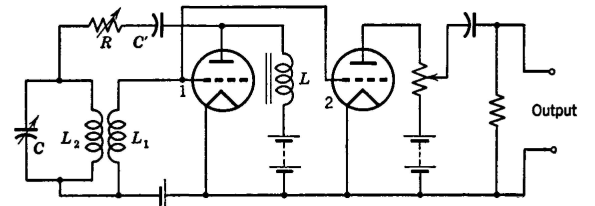| Electrical Communication is a free textbook on the basics of communication technology. See the editorial for more information.... |

|

Home  Electronic Applications in Communication Electronic Applications in Communication  Oscillators Oscillators  Inductance-Capacitance (L-C) Oscillators Inductance-Capacitance (L-C) Oscillators |
|||||






|
|||||
Inductance-Capacitance (L-C) OscillatorsThe frequency of oscillation of Fig. 35 is approximately the frequency of parallel resonance of the L2-C combination in the plate circuit. The feedback, necessary to sustain oscillations, is from coil L2 to L1. The grid is driven positive by an amount determined by the self-biasing Rg-Cg combination and by the coupling between L1 and L2. Often the tube is operated in class C. This is a tuned-plate oscillator. If capacitor C is placed in parallel with inductor L1, it becomes a tuned-grid oscillator.
A convenient oscillator for many purposes is the so-called resistance-stabilized oscillator of Fig. 36. Alternating voltage is developed across choke coil L, and alternating current is fed back to the parallel L2-C circuit through the series R-C' combination. The reactance of C' should be low at the frequency of oscillation, and R should be reasonably high, often about 50,000 ohms. The second tube of Fig. 36 is an isolating tube known as a buffer. This operates as an amplifier but, in addition, prevents changes in the impedance of the connected load from affecting the frequency of oscillation.
|
|||||
Home  Electronic Applications in Communication Electronic Applications in Communication  Oscillators Oscillators  Inductance-Capacitance (L-C) Oscillators Inductance-Capacitance (L-C) Oscillators |
|||||
Last Update: 2011-05-30



